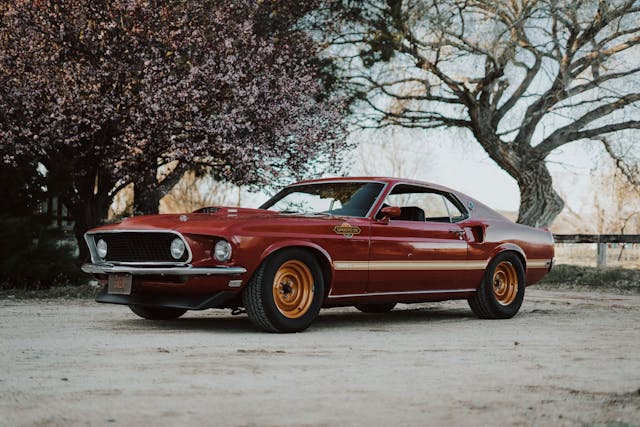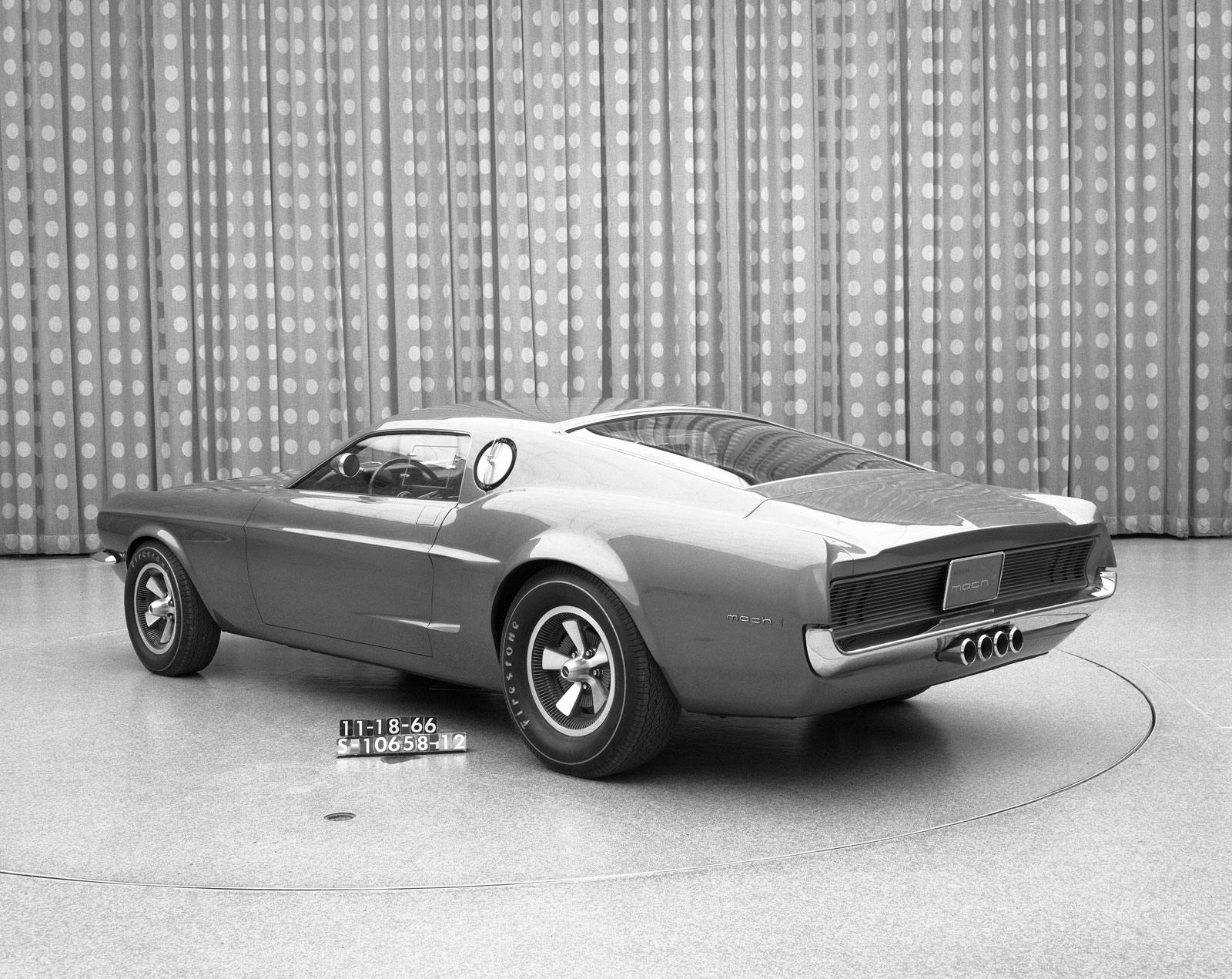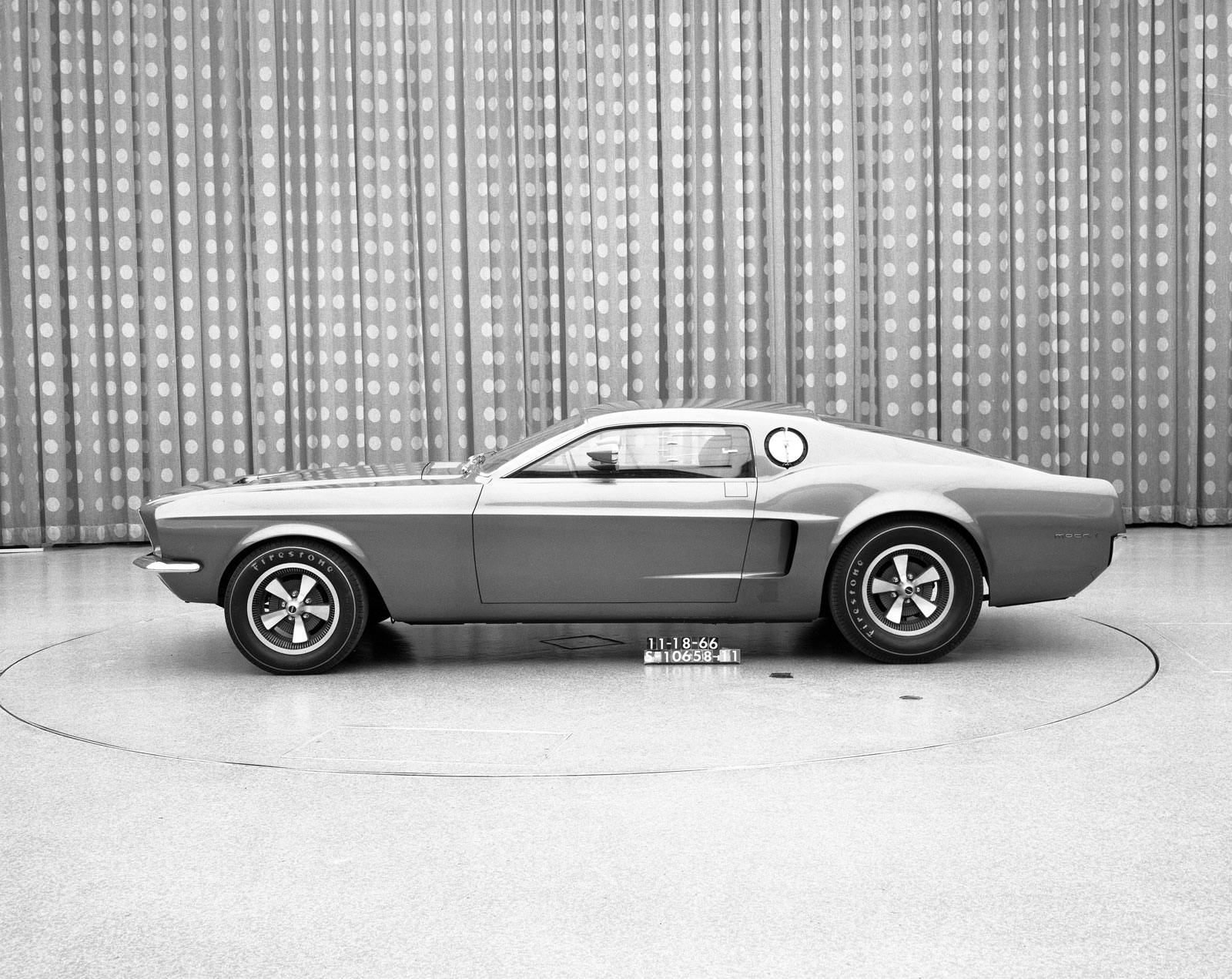Anticipating the 2021 Mustang Mach 1, we look back at the original run
If spy photos and rumors are correct, a new Mach 1 will be joining the Mustang line for 2021, replacing the Bullitt and slotted below the Shelbys. The Mustang line, which will include the electric Mach E late this year, hasn’t had this many hotrods since 1969, the year the first Mach 1 was introduced.
The Mach 1 name, which Ford borrowed from the technical term for the speed of sound, is revered in Mustang circles, even if some of the cars that wore the badge are not. Despite some weak-tea early 1970s models and the Mustang II version, the model’s significance to Mustang history has never diminished. Although a 2003–04 Mach 1 revival sold better than Ford had expected, the name has remained dormant since then. Details for the new Mach 1 are non existent at this point, but the prospect of another version put our wayback clock to 1969, the year the first Mach 1 was introduced.
So dust off your Shakers and polish those chrome tailpipe tips, and join us for run through the Mach 1’s history.
Baby T-Bird or muscle car?
The vast majority of 1965–73 Mustangs reflected Ford’s original vision for a sporty, stylish, and affordable coupe or convertible with a touch of Thunderbird flair. That was the Mustang’s success formula. The limited-production Shelbys revved up Mustang’s performance image, but there was no other specific Mustang performance model from 1965–68. Rather, Ford offered the 289 Hi-Performance through 1967, and, starting that year, the 390-cubic-inch four-barrel with 320 horsepower.
Ford sold just about 26,000 Mustangs with the 390 four-barrel in 1967. That figure dropped to about 10,000 for 1968 according to Kevin Marti’s “Mustang by the Numbers.” And that was out of 317,423 total Mustangs built.
Faster Ponies
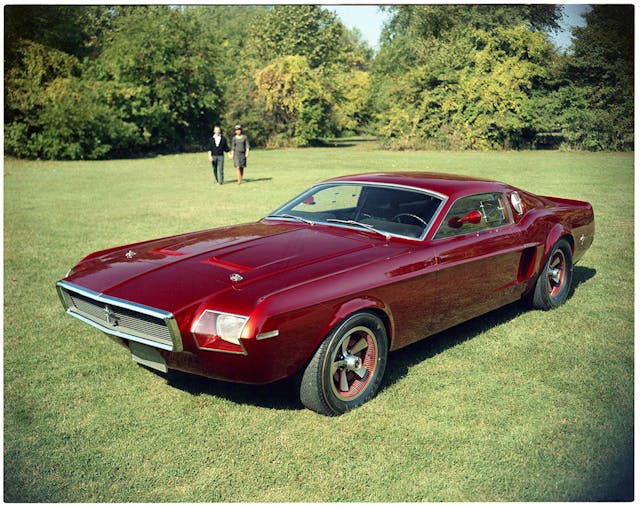
Ford stepped up Mustang’s street cred in late 1968 with the far more potent 428 Cobra Jet, underrated at 335 hp. Just under 3000 Mustangs got one. A hotrod Mustang was not as necessary for profits as it was for image. Ford was figuring that out.
The 390 and the 428 CJ were available for any 1968 Mustang. Many were ordered in conjunction with the GT package, a tasteful collection of cosmetic, interior, and suspension upgrades that was also available for the tamer V-8s. The Mustang GT was perhaps too tasteful for the youth market, and the Shelbys were too expensive and rare.
The Camaro SS 350 and SS 396 and Pontiac Firebird 400 deftly combined power with styling flair and image. Hood scoops (fake or real), mag-style wheels, chrome tailpipes, redline tires and accent stripes became as necessary as high horsepower. That was a lesson learned from the 1964 GTO’s success.
Ford was on the case. Shortly after the Camaro debuted in fall 1966, Ford showed a Mustang concept (above) called the Mach 1. Longer, lower, more muscular and far meaner looking than any production Mustang, it hinted at hotter things to come. Ford updated the Mach 1 concept’s styling for 1968 and put it back on the auto show circuit, stoking anticipation for a new model.
The Mach 1 arrives
Bulked up with a restyle for 1969, the Mustang looked racier than ever with a longer, pointier nose, capped by a wide grille and four-headlight styling. The fastback, with its single wide window and rear side louvers, was replaced by the new SportsRoof, which, unlike the 1967–68 design, had opening rear quarter windows. Non-functional rear brake air scoops in the quarter panels echoed the 1967–68 Shelbys.
The big news was the Mach 1 production model. Based on the SportsRoof body, it had all of the era’s performance styling frills: side accent stripes, blackout hood treatment, hood locking pins, “racing style” body-color mirrors, styled wheels with white-letter tires, and a faux hood scoop. A rear deck wing and rear window louvers were optional.
Car and Driver liked the look, saying, “Outwardly, the Mach 1 is a blend of dragster and Trans-Am sedan. In a year when every manufacturer offers hood scoops, Ford outdoes them all with an AA/Fuel dragster-style bug-catcher sticking right out through a hole in the hood.” The magazine was referring to the new optional Shaker hood, which not only looked cool but brought in cooler intake air.
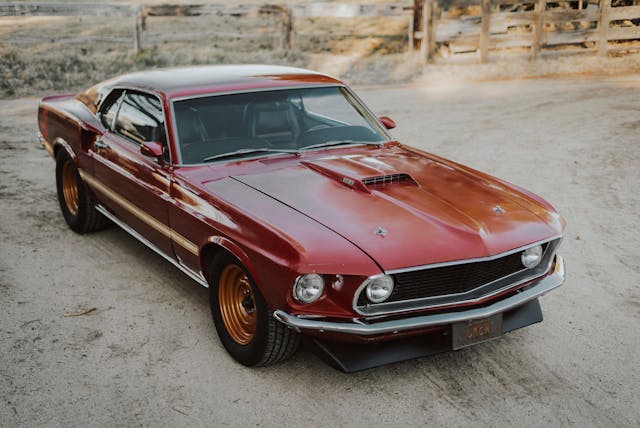
Here was the genius of the 1969 Mustang Mach 1: the hardware was off-the-shelf, meaning this was essentially a cosmetic repackaging of the GT with some extra goodies thrown in, and the owner able to choose the powertrain.
The base Mach 1 engine was Ford’s new 351 Windsor, a higher-deck, longer-stroke sibling to the 302. The standard H-code version with a two-barrel carburetor and single exhaust and running on regular-grade gas offered 250 horsepower (gross).
A measly $26 gave Mach 1 with a higher-compression, 290-horse M-code 351 with a four-barrel carb and dual exhausts ending in quad chrome tailpipe tips. A three-speed manual transmission was standard, with four-speed stick and three-speed automatic on the option sheet.
The 390 was still available for 1969, but the 351 four-barrel was lighter, nearly as quick and far more popular. Next up the Mach 1 option tree was the 428 CJ, with or without functional Ram Air. If you chose the optional 3.91 or 4.30 axle ratio for the CJ, the engine was upgraded to Super Cobra Jet status with some strengthened hardware to handle the quicker revving those ratios yielded.
All of those engines remained optional for any Mustang, so it was still possible to build a 428 CJ sleeper.
Pony stampede
The Mach 1 had company in the showroom for 1969, with Ford also adding the Boss 302 and Boss 429 models for performance purists. The Mach 1 was meant to be an all-around GT with race car design touches, a mass-market version of what the later Shelbys had evolved into.
To promote Mach 1’s all-around GT performance, Ford put together two national rally teams and won the 1969 SCCA Manufacturer’s Road Rally Championship. Banish any visions of Mustangs flying through the air like WRC Subarus, though. Road rallying was a much different sport, emphasizing timing precision over raw performance.
The Mach 1’s low $3122 base price also included an upgraded interior with “Comfortweave” vinyl bucket seats and a center console. The imitation teak wood dash, door and console trim looked quite upscale. The Mach 1 also packed an additional 55 pounds of sound insulation, making for a surprisingly quiet ride that road testers praised.
A sales hit
Automotive media liked the Mach 1, for the most part. Said Car and Driver about its 1969 428 CJ test car: “It may just be that this time the stylists have done too good a job. Look at the Mustang Mach 1 and you expect miracles—drive it and they are not forthcoming. The pieces are there—most of them anyway—but the sum is far short of its parts.”
Car and Driver complained about the car’s 59:41 percent weight distribution, which hurt agility. And, the 428 CJ easily overwhelmed the skinny F70-14 Goodyear Polyglas GT tires. The magazine’s best quarter-mile was 14.3 seconds at 100 mph.
High-Performance Cars magazine hot-shoe Joe Oldham battled wheel hop and fiddled with tire pressures on a Mach 1 SCJ to run the quarter in 13.74 at 105 mph. He noted that, “On the street, the 4.30 rear end made highway cruising a tense, noisy affair.”
The most popular Mach 1 performance upgrade was the 351 four-barrel. Testing an automatic-equipped model with a 3.25:1 rear axle ratio, Hot Rod covered the quarter-mile in 15.46 seconds at around 90 mph. Advancing the 351’s timing, removing the air cleaner and opening the hood scoop cut that to 15.13 at 93 mph.
The Mach 1 proved to be just what the market wanted, with Ford building 72,459 for 1969. No competitor came close. The same year, Ford sold just 6,694 GT-equipped Mustangs, so that option did not return for 1970.
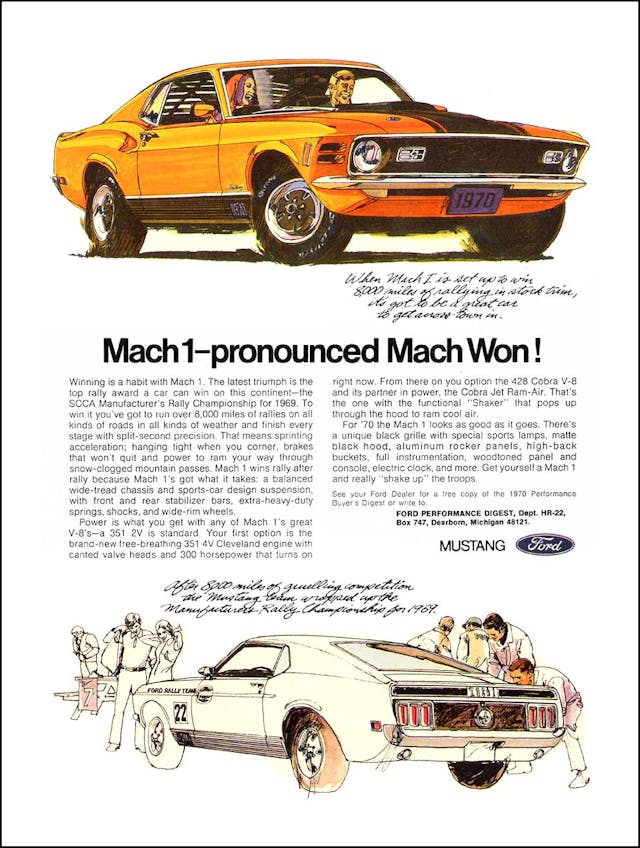
Sizzling ’70
Ford refreshed Mustang’s look for 1970, reverting to a two-headlight style, recessing the taillights and eliminating the fake rear brake scoop on the SportsRoof body. The Mach 1 returned with its own new look, now using model badges instead of decals, and featuring a ribbed rocker panel with the distinctive Mach 1 script. The black-out hood was narrower, with engine-displacement callouts flanking the hood scoop. “Sport Lamps” in the grille were really a second set of parking lights.
The engine lineup changed a bit: the 390 was dropped, and the all-new 351 “Cleveland” replaced the 351 Windsor. The name reflected the manufacturing plant’s location. The new engine shared only its bore and stroke dimensions and displacement with the 351W. The block and canted-valve heads were unique, with huge ports and valves, even on the two-barrel version.
The H-code 351C two-barrel was rated at the same 250 horsepower as the 1969 351W, but the M-code four-barrel version was now up to 300. The 1970 Mach 1’s dual exhaust system (on four-barrel models) replaced the constrictive transverse muffler and dual resonator setup for two inline mufflers. Ford added a Hurst shifter for the four-speed and gave the Mach 1 a rear stabilizer bar.
Performance was quicker than the 1969 351W Mach 1. Car Craft’s 351 four-barrel, four-speed Mach 1 road test car did the quarter-mile in 15.2 seconds at 94 mph without tweaks.
In a fading pony car market, Mustang remained the leader, but production dropped to 191,522 cars. The Mach 1 accounted for 40,975 of those, still the most popular performance pony car. The 428 CJ and SCJ sold in very small numbers—less than 4000 across all Mustang models for 1970.
Bigger was not better
Talk about bad timing. Just as the pony car market was shrinking, Ford introduced a bigger Mustang. Design work had begun in 1967, when Ford gambled that the market would want even bigger, more powerful engines and more room in pony cars. The longer, wider, heavier 1971–73 Mustang proved to be the least popular version in the car’s history.
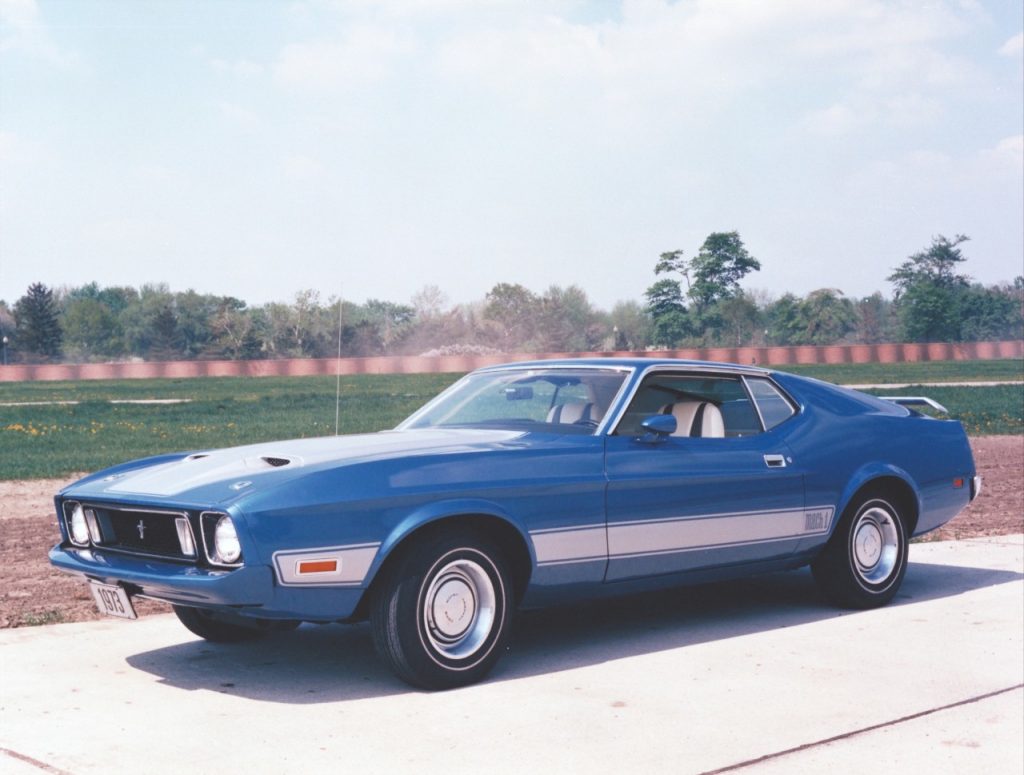
The SportsRoof’s near-horizontal roofline was controversial, but gave the Mach 1 a wicked look. Underneath, though, the Mach 1 had been weakened, with the base engine now the 302 two-barrel rated at 210 horsepower. (The 1972 net rating showed the 302’s true form at 140 hp.)
The 351C two-barrel and four-barrel returned with slightly lower gross power ratings than 1970 (240 and 285, respectively). The new 429 Cobra Jet engine option was rated at a stout 370 hp, or 375 hp with the Drag Pack option (Super Cobra Jet).
The Mach 1’s optional Ram Air system now used dual integrated NACA scoops, and a non-functional version of the hood was available on the Mach 1 and other Mustangs. Ford further downgraded the Mach 1 to the base Mustang interior to keep the starting price to under $3300. A “Sport” interior was a $130 option.
The Boss 351 model and 429 CJ engine were one-year wonders, each selling fewer than 1900. Late in the year, a new Q-code 351 Cobra Jet replaced the M-code and would continue through 1973. The 351 CJ was a solid performer, with an impressive-for-the-time 266 net horsepower. Once again, you could get the top engine in any Mustang.
Ford sold just over 410,000 1971–73 Mustangs, which was low for Mustang but kept it tops in the segment. The Mach 1 accounted for nearly 100,000 of those, although, admittedly, many were not really performance models.
And then came what some enthusiasts consider, perhaps unfairly, the Mustang apocalypse: the Mustang II. There was a Mach 1, but the V-8 option did not arrive until the second model year, 1975. It was the same engine that was standard in 1971–73, so at least in this lighter car, it offered somewhat better performance.
“Better” is a relative term, of course. With 0–60 in 10.5 seconds and the quarter-mile in 17.9 according to Road & Track, about the best thing you could say for the Mustang II Mach 1 V-8 was that it was quicker than a Chevy Monza V-8. Times were tough.
When the Mustang got its performance mojo back in 1982, the GT badge returned.
Mach 1 revival
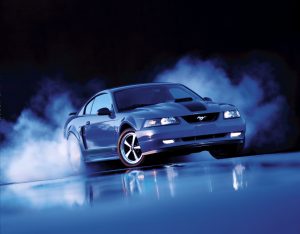
Ford redeemed the Mach 1’s reputation with a revival model in 2003 and ’04, closing out the SN95/Fox 4 platform. The DOHC 4.6 Modular V-8 was a revised version of the engine from the 2001 SVT Cobra and inhaled a portion of its air through a Shaker hood scoop, just like the 1969–70 Mach 1.
There was nothing retro about the Mach 1’s honest 305 net horsepower. Motor Trend clocked a 13.2-second quarter-mile at 106.7 mph with a five-speed model, making it the quickest Mach 1 ever. Ford anticipated building 6500 Mach 1s for 2003, but the car returned for 2004 to meet strong demand. Ford ended up selling nearly 17,000 total.
With an EcoBoost four-banger that runs 13s, a GT, two Shelbys and a new Mach 1 in the Mustang corral for 2021, it’s better than traveling back in time to 1969—and much easier.
